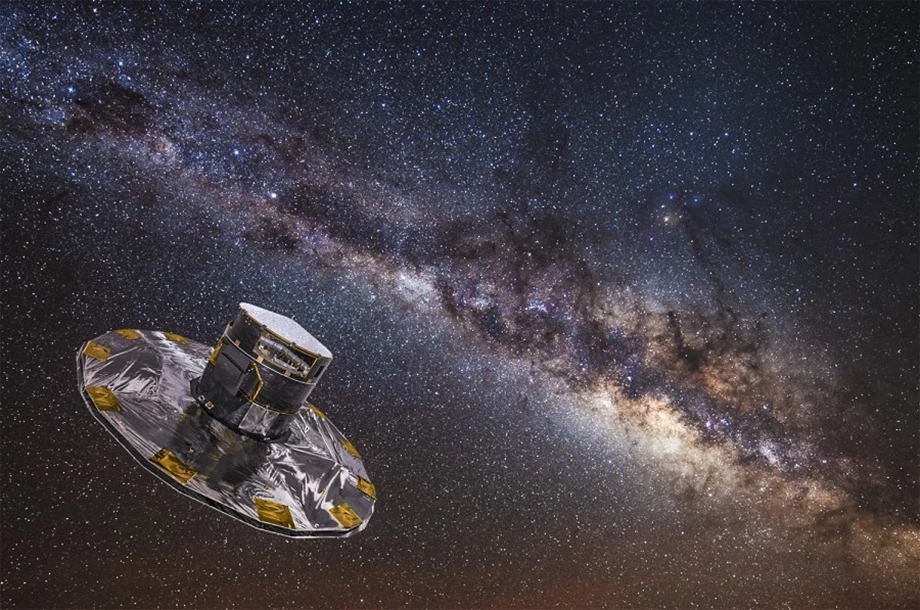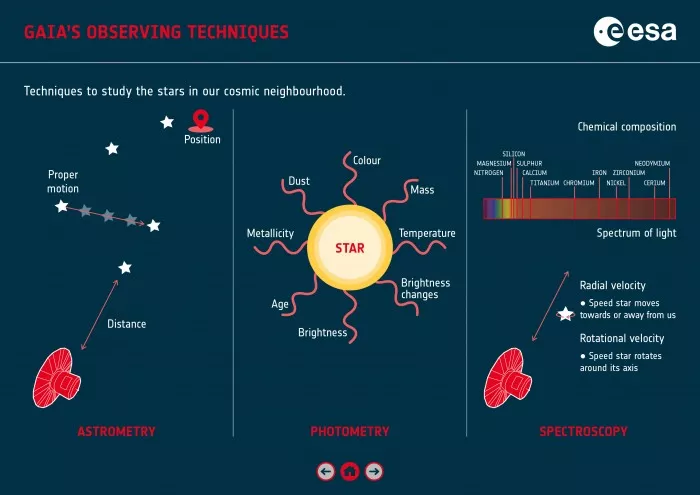According to the US space network, the European Space Agency's Gaia probe will release the latest batch of observation data on June 13, which contains information about hundreds of millions of the brightest objects in the sky, such as the chemical composition of tens of millions of stars. The "Gaia" space telescope was launched in 2013, aiming to draw the most detailed map of the Milky way by depicting the precise position, distance and speed of nearly 2billion stars in the Milky way.
Astronomers say that although these 2billion stars account for only about 1% of the total number of stars in the Milky way, with the support of complex algorithms and other information, they can use these data to see the whole picture of the Milky way and solve some major mysteries about the Milky way and its stars.

Where do stars come from
By measuring the precise positions, distances and velocities of a large number of stars, "Gaia" can present not only the current "appearance" of the Milky way, but also its past. Because the objects in the universe follow certain physical laws, astronomers can use existing data to simulate the past trajectories of these stars, so as to understand the "story" that has been staged in the Milky way in the past millions or even billions of years. With the help of previously obtained data, scientists have been able to do this, and the new data set allows them to do more.
In the new data set, "Gaia" team will announce the "astrophysical parameters" of 500million stars for the first time. Jos de Bruin, a scientist of Gaia project, pointed out that these parameters come from the spectra of stars measured by Gaia (essentially the "fingerprint" of light absorbed by these stars), revealing the chemical composition, mass, age, temperature, brightness and other information of each measured star.
Bruin said that the chemical composition of the atmosphere of 30million stars is the same as that of the molecular cloud of these stars born billions of years ago. By combining the chemical composition information with the modeling of star trajectories, astronomers can track the birthplace of star clusters inside (including outside) the Milky Way galaxy.
How the Milky Way Galaxy connects

Although Gaia has been scanning the Milky way since 2014, there are still many unsolved mysteries in the Milky way, and it is not easy to study it. Because he was inside the Milky way, Gaia could not even penetrate the thick dust and gas clouds that covered the center of the Milky way and peep at the other side of the silver disk.
However, with the increasing data collected by Gaia and the help of other observation technologies such as radio astronomy, the full picture of the Milky way is slowly emerging. Scientists are getting closer and closer to solving major puzzles such as how to distribute dark matter in the Milky way.
Bruin explained: "all the matter in the Milky Way exerts gravity on each star, and this gravity determines the speed of the star. Therefore, by measuring the motion of the star, we can detect the distribution of matter in the Milky way, which is very important to understand how the Milky way is connected."
Another mystery related to the distribution of stars in the Milky way is related to the Milky Way's signature spiral structure, the spiral arm. Most astronomers agree that the four spiral arms of the Milky Way Galaxy seem to be emitted from the center of the Milky Way galaxy and composed of stars and gas, but there are still many disputes about the size of a single spiral arm and their exact location in the silver disk. The new data may help astronomers better understand these problems.
Moreover, "Gaia" can not only see the present appearance of these spiral arms, but also help astronomers simulate the past appearance and future evolution of these spiral arms.
Anthony brown, an astronomer at Leiden University in the Netherlands and chairman of Gaia data processing and Analysis Association, said that with these new data, astronomers will be able to see further and directly sample a larger part of the spiral arm. Nevertheless, understanding the entire galaxy remains a challenge.
What happened to the "childhood" of the galaxy
In addition, the data provided by Gaia enabled astronomers to conduct so-called "Galactic archaeology". By reconstructing the tracks of millions of stars, they can understand the events that occurred billions of years ago, including the disastrous collision between the Milky way and other galaxies. The ripples caused by the collision can still be observed in the Milky way.
In the data previously released by Gaia, scientists discovered the collision between the Milky Way galaxy and the smaller galaxy called Gaia Enceladus, which occurred 8billion to 11billion years ago. At that time, the Milky way was much smaller than it is now. Brown said that the collision with Gaia Enceladus was "the last major merger of the Milky Way Galaxy in its childhood". He hopes astronomers can use the new data set to further review the history of the Milky Way galaxy and track some earlier collisions.
To this day, the Milky way is still devouring smaller galaxies. The model shows that the Large Magellanic Cloud and the wheat Magellanic Cloud, two dwarf galaxies running around the periphery of the Milky way, will one day be completely swallowed up by the Milky way.
Just as it was born from violent collision, the Milky way will die from violent collision one day. In about 4.5 billion years, the Milky way will collide with its nearest large galaxy neighbor, Andromeda. Brown said that the newly released Gaia data may bring some enlightenment to this catastrophic event.
Bruin said that "Gaia" is the scientific task that currently produces the most scientific papers. The data released on June 13 will also contain the largest set of information about the Galactic binary system in history. It is expected that these data will also lead to some breakthrough discoveries. In addition, Gaia has also established the largest chemical composition database of asteroids in the solar system so far. Scientists are also developing better and better algorithms to learn more about the stars seen by Gaia.
The Gaia space telescope will continue to scan the sky until it runs out of fuel in 2025.